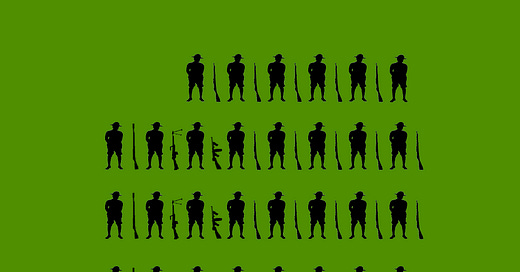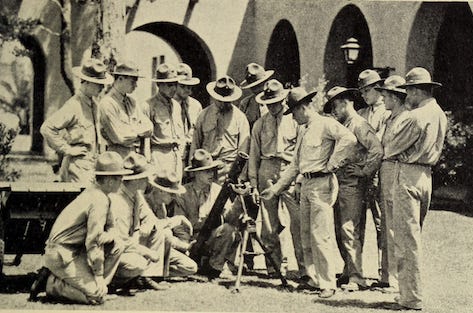The estate of the late John Sayen has graciously given permission to the Tactical Notebook to serialize his study of the organizational evolution of American infantry battalions. The author’s preface, as well as previously posted parts of this book, may be found via the following links:
In November 1934, the Marine Corps published its first organizational tables specifically designed for the new Fleet Marine Force (FMF). These covered only the six infantry battalions and their component rifle and machine gun companies (see Appendices 4.13, 4.14 and 4.15). Tables covering the rest of the FMF did not appear until the following February. The new tables reflected much of the experience gained in China and Nicaragua.
Nicaragua had been a war of patrols and ambushes. Units larger than companies rarely operated tactically. Patrolling was typically done with a reinforced platoon. Such a platoon needed extra firepower, an extra officer and its own cook and Navy hospital corpsman. Also, Nicaragua showed that a rifle company really needed at least three platoons rather than two (though companies found it hard to find cooks and hospital corpsmen for three platoons).
FMF rifle companies would therefore have three platoons but in order to keep them within manpower constraints, no platoon could have more than three squads. The rifle sections would therefore disappear. To beef up firepower, each squad would get both a Thompson sub-machine gun and a Browning automatic rifle (BAR).
A further complication for the new FMF rifle company (Appendix 4.13) was that, officially, at least, it could have no more than three officers. This left no officer to command its third platoon so each company would receive a gunnery sergeant who would supposedly act as the third platoon commander. In practice, however, there were plenty of extra officers available to command that third platoon.
As in the previous decade, Congress continued to officer the Marines for about 40% more enlisted men than Congress was actually paying for. Thus all platoons normally had officers and the gunnery sergeant usually ended up at company headquarters assisting with supply and ordnance matters and providing the company commander with additional senior enlisted leadership. Gunnery Sergeants were already serving in a similar fashion in the machine gun and howitzer companies.
In the machine gun and howitzer company (Appendix 4.14), the howitzer platoon remained much as it had been in 1929. However, in order to work in a third machine gun platoon (so that one could be attached to each rifle company), the two existing machine gun platoons had to be reduced. A machine gun squad would have only five men (with a private first class as squad leader) or about half as many as a wartime squad. A corporal would command a section of two squads.
Even a full strength squad could barely move its gun and ammunition on its two very heavy Cole carts, with their elaborate caisson and trailer arrangement. Draft animals could help but were only infrequently available. However, the seven men in each platoon headquarters’ ammunition squad would have eased this situation somewhat though they could not handle a cart for each machine gun squad.
Ironically, the third machine gun platoon was, in practice, usually left unmanned as an economy measure. Its impact was therefore mainly symbolic. As in 1929, the machine gun and howitzer company was authorized rifles for most of its enlisted men so that it could supplement the rifle companies in performing guard duties. When machine gun and howitzer company functioned in its primary role, the rifles remained in the company chests.
The FMF battalion headquarters company (Appendix 4.15) was also austere. However, the battalion headquarters was actually a little larger than its Army counterpart. Furthermore, the Marines departed from the Army’s practice of placing staff officers and their assistants in the battalion headquarters. Thus, the assistants to the logistics officer (Bn-4) served in a separate supply section while those of the intelligence officer (Bn-2) could be found in the intelligence section. Medical arrangements were equally austere. Only enough hospital corpsmen were available to allow one per rifle or machine gun company with enough left over to man a skeletal aid station.
The communication platoon still operated mainly by runner or messenger, visual signal, or telephone. There was only enough telephone equipment to link the rifle and machine gun company headquarters to the battalion headquarters. The platoon’s three Cole carts (including its RL-16 reel-laying cart) were not assigned to specific entities in the platoon but one cart normally carried the radio while the other two hauled wire and telephone equipment.
The remaining FMF organization tables that were published in February 1935 described no unit larger than a regiment (see Appendix 4.16). All units would instead serve as “building blocks” for the construction of task organized brigades or infantry task forces built around battalions or regiments. However, since only about 4,400 enlisted men could be allocated for the entire FMF (including its aviation) there was not a lot to work with. Therefore, the two FMF infantry regiments were generally unable to form their third battalions or their service companies. Their headquarters companies existed only as small cadres (three or four officers and 17 enlisted men each) and their service support had to come from the service companies of their respective brigades.
The organization of the regimental headquarters company was supposed to parallel that of the battalion headquarters companies. The intelligence section had only scouts and observers. The regimental pioneer platoon survived despite even though the Army was phasing it out in favor of a battalion level pioneer section. The Marine unit however seems to have been more for light engineering work than merely furnishing ammunition-carrying parties. The Navy medical section included a dental officer. The communication platoon was but an enlarged version of its battalion level counterpart.
The staff and supply sections of the rarely existing regimental service company were supposed to function in much the same way as they did in Army service companies. However, the supply section did not include an ammunition group, the munitions officer and sergeant being part of regimental headquarters. The regimental supply officer (R-4) also commanded the supply company. The pay section was a standard feature of any regimental sized Marine Corps unit. There was no transportation unit.
Transportation would be attached on an “as needed” basis and would consist of a number of attached motor transport sections, platoons, or companies. In general, these motor transport units were meant to support battalions, regiments, or brigades, respectively, though there were no firm rules on this. Each came equipped with a number of cargo vehicles (either two-ton trucks or Holt tractors towing three-ton trailers) plus 1/2-ton trucks, five-passenger automobiles, water trailers, motorcycles (with or without sidecars), and ambulances.
The appendices to this post can be found by means of the following link, which will take you to the Military Learning Library, a website that I maintain.






